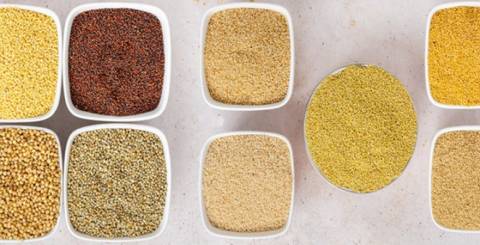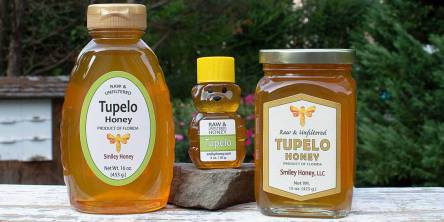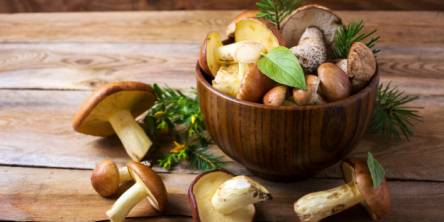Millets Benefits - Positive, Negative and Neutral Millets

Abstract
Millets are a profoundly different group of little cultivated grasses, broadly grown all over the world as cereal yields or grains for cattle fodder and human food. Most species by and large alluded to as millets have a place with the clan Paniceae, however, a few millets likewise have a place with different other taxa. People in India used to consume the traditional food of millet but wheat has changed the trend and led to various health issues such as diabetes and associated disorders though it has some benefits as well. In the further section, we shall discuss the millets (positive, neutral and negative) and their benefits. Let's see!!
Introduction
Millets are significant harvests in the semiarid jungles of Asia and Africa (particularly in India, Niger, Mali and Nigeria,), with 97% of millet creation in developing nations. This yield is inclined because of its efficiency and short developing season under high-temperature and dry conditions. Millets are native to many pieces of the world. The most broadly grown millets are pearl millets and sorghum, which are significant yields in India and portions of Africa. Finger millet, proso millet, and foxtail millet are likewise significant harvest species. Millets have been consumed by people for around 7,000 years and possibly had "a critical job in the ascent of multi-crop horticulture and settled cultivating social orders.
Millets Can be Divided into Three Subgroups
- Positive millets
- Neutral millets
- Negative millets
Description
1. Positive Millets
Positive millets include foxtail millet, browntop millet, kodo millet, barnyard millet and Little millet
2. Neutral Millets
It includes sorghum (jawar), pearl millets (bajra), finger millet (ragi), proso millet and corn
3. Negative Millets
Negative millets are wheat and paddy (rice).
1. Positive Millets
1. Foxtail millets
It is also known as kangani. It has Italian origin. It has fibre of around 7% It acts as a brain tonic and is essential in neurological problems. It also affects the respiratory system positively and is beneficial in respiratory disorders. It helps in sciatica as it helps in the skeletal system. Foxtail millets are also high in protein content. It helps with a number of psychological and neurological problems and works amazingly in epilepsy, arthritis and Parkinson’s disease.
2. Brown top Millets
Browntop millets are also known as hari kangani. It has American origin. It works amazingly in different systems of the body namely the neurological system, digestive system and skeletal system. Browntop millets work amazingly in the condition of chronic constipation. It has a fibre content of 12.5 %. Furthermore, browntop millets have good results in arthritis, hypothyroidism, eye disorders, thyroid problems, hypertension and obesity.
3. Kodo Millets
It is pinkish in colour. It is best used in haematological problems. It helps in blood cancer, anaemia, bone marrow issues, allergic conditions, leukocytosis, thrombocytopenia, ITP, and the disorders of the raktavaha srotas. It helps in maintaining the levels of creatinine and reduces cholesterol and triglycerides. This has a number of health benefits. Patients with blood disorders must consume the Kodo millets at the latest for three days for breakfast, lunch and dinner as well. It has fibre content of about 10% Kodo millets are of best help in insomnia, diabetes, weak immunity, constipation, anaemia and impurities of the blood.
4. Barnyard Millets
Barnyard millets are also known as Japanese or German millets. These millets are of choice in the disorders of the liver. It has around 11 % fibre. It helps wonderfully in soft tissue disorders and magically works in hepatomegaly and splenomegaly. Barnyard millet excels with its goodness in managing the conditions of the liver, kidney, spleen, excessive bad cholesterol and endocrine glands.
5. Little Millets
Little millets contain around 10 to 11 per cent fibre. This is known as kutki in Punjabi. It works impeccably in the disorders of the reproductive system such as azoospermia, erectile dysfunction and various others as well. Further, it balances the hormones in the body and hence is beneficial in female reproductive system issues. With the above-mentioned properties, little millets are helpful in PCOD (polycystic ovarian disease), uterine fibroid, male and female infertility
2. Neutral Millets
1. Sorghum
Sorghum is known as jowar and is considered neutral millet thus can be consumed regularly according to the season ongoing. It is gluten-free and has no glycemic index. It works nicely in nerve degeneration conditions. It is a rich source of magnesium and phosphorus. It has a hot potency. Sorghum reduces inflammation. It contains antioxidants that help in fighting the ageing signs and also it also exhibits anti-cancer properties. It has 4 g of fibre
2. Pearl Millet
Pearl millet is also known as Bajra and is a great component of a diabetic diet, that provides a stable glucose level in the bloodstream. It helps in lowering the cholesterol level, thus beneficial in heart patients. It is gluten-free. It is useful in stomach ulcers and acidity. Due to its higher fibre content of 1.3g, it helps in relieving constipation. It is a good source of protein. It is good for lowering high blood pressure.
3. Finger Millet
The minerals, fibre and nutrients found in finger millet can give significant medical advantages. The potassium found in finger millet can assist with keeping your kidneys and heart working appropriately. Potassium likewise assists your nerves with communicating signals, which permits your cerebrum and your muscles to cooperate without a hitch. Finger millet is also known as Ragi, according to Ayurveda, it is tridosha shamak, which helps in the burning sensation in the hands and feet.
- It has a fibre content of around 3.6 g.
- It supports the good bacteria in the gut
- Finger millet is an excellent source of niacin, vitamin A, vitamin B, calcium, iron, phosphorus, potassium, and antioxidants.
- Finger millets controls bad cholesterol and thus helps in atherosclerosis
- A low glycemic index makes it a useful meal for the diabetic patient.
4. Proso Millet
Proso millet is of great use in diseases of the nervous system as it contains a good amount of lecithin as it helps in strengthening the nervous system. The Proso millets are beneficial in reducing the bad cholesterol levels in the body as it contains phytic acid that reduces bad cholesterol level. It acts as an anti-ageing agent due to its antioxidant richness that removes free radicals from the body. It works wonderfully in diseases of the skin. As it is devoid of gluten this is a good diet for celiac patients. As it contains high amounts of magnesium it is helpful in checking the levels of glucose in the patient with diabetes and hence controls the type 2 diabetes. Further, it has a decent amount of calcium thus helping in strengthening the bones. It has a fibre content of 2.2 g.
5. Corn
Corn is known as corn silk and is commonly known as Makka/makki. It is of great help in prostatomegaly, kidney dysfunction and bed wetting. It manages cystitis, oedema, kidney stones, and urinary infections as it acts as a diuretic. It promotes and boosts the health of the kidney. It also helps in reducing cholesterol levels and blood glucose levels. It helps in anaemia, protects the heart, helps in weight gain and is good for the eyes and skin. It helps in the prevention of cancer and promotes healthy cell division.
3. Negative Millets
1. Wheat
Wheat is a new grain that provides energy to the body and has a high glycemic index but contains some proteins such as gluten that cause problems in some patients that are intolerant to gluten. Further, it has several benefits and it has been in regular use in India particularly in the north. It has 1.2 g of fibre.
2. Rice (paddy)
Rice is widely grown all over India and is a source of instant and fast energy. It is generally used in some of the states of India every day. It has 0.2 g of fibre. Though a good source of instant energy and easy to digest and helps in weight gain and though not so good for gut health due to its low fibre content it can cause constipation.
Conclusion
Millets are of great help in managing diseased conditions and maintaining the health status of a man and thus with property these also help in achieving the objective of Ayurveda. Millets are of great help in almost every condition and are a great source of fibre. Furthermore, due to the low glycemic index, positive and neutral millets are helpful in maintaining normal blood sugar levels. Millets were in use in ancient times and people were healthy but today the new grains have taken the place of ancient millets. And further chemical fertilisers and pesticides have made them more harmful. Thus this is the need of time that we must switch our diet to millets and stay positive and healthy and we should also spread the usefulness of the positive and neutral millets and discard the use of harmful wheat and rice at earliest.
Similar Articles
Diet and energy metabolism have been shown to affect gene expression greatly, which in turn influences human health and disease. Epigenetics serves as a mechanistic link between energy metabolism and gene expression control.
Dealing with digestive problems on a regular basis can be difficult. An upset stomach, gas, heartburn, nausea, constipation, or diarrhea are all too prevalent and can have a negative impact on your quality of life. The good news is that simple dietary modifications can do wonders for your gut health, potentially relieving many issues
Different people have different likes and dislikes. Some people prefer spicy food while some can’t tolerate spicy food. Some develop allergies after having peanuts or smelling a certain type of flower.
Feeling shy to talk about it? Worried why it looks like that..?Worried what might be the reason.? Or are you someone not bothering to even care at all.? Does it look like porridge or does it resemble pudding? Did you notice a sudden change in the consistency or colour?
Tupelo honey is a light golden amber-colored honey with a greenish cast that tastes delicious, buttery, and stands out from other types of honey. Tupelo honey comes from a tree that grows only in wet swampy soil which is generally found in Florida.
According to the World Health Organization (WHO), a lack of adequate nutrition causes the majority of diseases in older people, which is why a healthy diet is so important in elderly care. Fat, for example, has been related to prostate, colon, and pancreatic cancers.
Inadequate blood circulation causes several severe, sometimes life-threatening diseases. The body is a complex machine. To keep working smoothly, it needs the right nutrients. The body also needs certain vitamins to maintain healthy blood circulation.
Mushrooms are well-known for their meaty, rich taste. Shiitakes were grown in the United States in the late 1970s and have been popular in Asia for over 1,000 years. They are currently available in most food stores. Shiitakes are brown or dark gray, and the caps usually grow to 2 to 4 inches in width
You know how important it is to have a balanced diet, but sometimes the hustle of your daily life does not allow you to eat well. So, first of all, you should be clear about the dieting concept.









